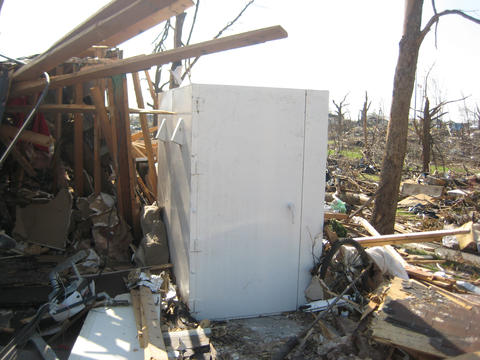
A steel shelter bolted to a concrete garage floor was all that remained of a wood-frame home destroyed in the Joplin, Mo., tornado of May 22, 2011. NIST researchers studied this, and other in-home shelters, as part of the agency's investigation of the storm's impacts.
The National Institute of Standards and Technology (NIST) has released the final report on its technical investigation into the impacts of the May 22, 2011, tornado that struck Joplin, Mo. The final report is strengthened by clarifications and supplemental text suggested by organizations and individuals from across the nation in response to the request for comments on the draft Joplin report, released Nov. 21, 2013.
The revisions did not alter the investigation team's major findings or its 16 recommendations, highlighted by NIST's call for nationally accepted standards for building design and construction, public shelters and emergency communications that can significantly reduce deaths and the steep economic costs of property damage caused by tornadoes.
NIST will now work with the appropriate code development organizations to use the study's recommendations to improve model building codes and lay the foundation for nationally accepted standards. NIST also will work with organizations representing state and local governments—including building officials—to encourage them to consider implementing its recommendations. These include calls to develop and adopt:
- Nationally accepted performance-based standards for the tornado-resistant design of buildings and infrastructure to ensure the resiliency of communities to tornado hazards;
- Standards for designing and constructing essential buildings—such as hospitals and emergency operations centers—and infrastructure to remain operational in the event of a tornado;
- Design methods that will ensure all building components and systems meet the proposed performance objectives;
- Uniform national guidelines that enable communities to create safe and effective public sheltering strategies; and
- Nationally accepted codes and standards, as well as uniform guidance for clear, consistent and accurate emergency communications.
The report also includes a number of recommendations for future research and development of technologies and strategies to advance tornado wind measurements, strengthen emergency communications, increase warning time, create more accurate tornado hazard maps and improve public response during tornado events.
The NIST Joplin tornado study was the first to scientifically study a tornado in terms of four key aspects: storm characteristics, building performance, human behavior and emergency communication—and then assess the impact of each on preventing injury or death. It also is the first to recommend that standards and model codes be developed and adopted for designing buildings to better resist tornadoes.
The tornado in Joplin was rated by the National Oceanic and Atmospheric Administration's National Weather Service (NWS) as category EF 5, the most powerful on the Enhanced Fujita scale. The massive storm impacted an area 35 kilometers (22 miles) long, destroyed some 8,000 structures in its path and killed 161 people. This makes it the single deadliest tornado in the United States in the 64 years that official records have been kept.
The complete text of the final report, Technical Investigation of the May 22, 2011, Tornado in Joplin, Missouri is available at www.nist.gov/manuscript-publication-search.cfm?pub_id=915628. Additional information about the tornado event and the NIST investigation, may be accessed online.

